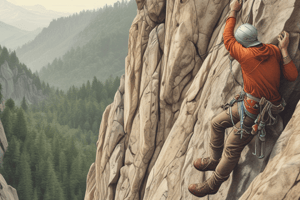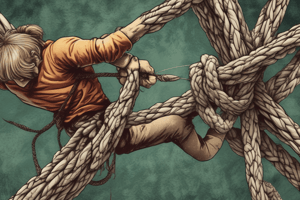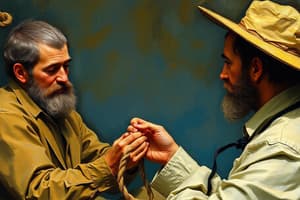Podcast
Questions and Answers
What is the primary purpose of the Alpine Butterfly Knot?
What is the primary purpose of the Alpine Butterfly Knot?
- To attach a rope to an anchor bolt
- To tie a secure loop at the end of a rope
- To tie a secure loop in the middle of a rope (correct)
- To join two ends of a rope together
In what type of ropes is the triple fisherman's knot recommended?
In what type of ropes is the triple fisherman's knot recommended?
- Nylon ropes
- Cotton ropes
- Kevlar ropes
- Slippery, stiff ultra-high-molecular-weight polyethylene and aramid cored ropes (correct)
What is a key advantage of the Munter Hitch?
What is a key advantage of the Munter Hitch?
- It is only used for glacier climbing
- It is adjustable without untying
- It does not require a belay/rappel device (correct)
- It is a quick-release knot
What type of carabiner is recommended for use with the Munter Hitch?
What type of carabiner is recommended for use with the Munter Hitch?
What is an ideal use case for the Double Hitch Knot?
What is an ideal use case for the Double Hitch Knot?
What is the primary purpose of using a single figure-eight knot?
What is the primary purpose of using a single figure-eight knot?
Which knot is recommended for joining two ropes of unequal size?
Which knot is recommended for joining two ropes of unequal size?
What is a common use of the Figure-Eight on a Bight knot?
What is a common use of the Figure-Eight on a Bight knot?
What is a characteristic of the Reef Knot or Double Knot?
What is a characteristic of the Reef Knot or Double Knot?
What type of situation is a Bowline Knot typically used in?
What type of situation is a Bowline Knot typically used in?
Flashcards are hidden until you start studying
Study Notes
Types of Knots
- Half knot, a basic stopper knot used by climbers as a safety knot, can be jammed if tightened strongly.
Reef Knot/Double Knot
- Used for multiple purposes, such as tying bundles, securing bandages, and joining same-sized ropes.
- Flattens when tightened, but not recommended for lifting heavy loads or strains.
Single Figure-Eight Knot
- A type of stopper knot, usually at the end of a rope.
- Basis of many other complicated knots used in rock climbing.
Figure-Eight on a Bight
- Used to secure a bight at the end of the rope, commonly used to "tie-in" to the rope.
- Good for quickly anchoring a rope or anchoring oneself to a belay station.
Figure-Eight Bend Knot
- Looks similar to the figure-eight on a bight, but with two loops.
- Can be hooked into two anchor points, forming a stable and secure setup for caving and climbing.
Sheet Bend/Weaver's Knot
- Recommended for joining two ropes of unequal size.
- Can be used to lengthen a rope, for example, when combining two pieces of rope.
Bowline Knot
- Used as a rescue knot in cases of mountain climbing, fires, or water accidents.
- Forms an open loop that is easy for someone to grab onto and be pulled up out of a dangerous situation.
Alpine Butterfly Knot
- Used to tie a secure loop in the middle of the rope.
- Can be used to secure a middle climber on a rope with three or more people attached to the climbing rope.
Triple Fisherman's Knot
- A bend knot, used to join two ends of rope together.
- Recommended for tying slippery, stiff, or high-molecular-weight polyethylene and aramid cored ropes.
Munter Hitch
- Provides a method for belaying and rappelling without a belay/rappel device.
- Works by using the friction between rope and carabiner, controlled by the user.
Double Hitch Knot/Munter Hitch
- Ideal for fast attaching/securing oneself to an anchor bolt, belay or rappel station.
- Adjustable without untying, making it well-suited for use as a personal anchor knot.
Studying That Suits You
Use AI to generate personalized quizzes and flashcards to suit your learning preferences.




